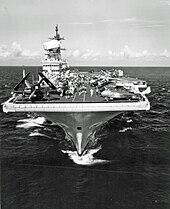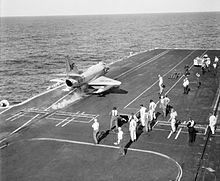HMS Victorious (R38)
|
||||||||||||||||||
|
||||||||||||||||||
|
||||||||||||||||||
|
||||||||||||||||||
The HMS Victorious (R38) was the second aircraft carrier of the Illustrious class of the Royal Navy , who was appointed as part of the Flottenbauprogramms 1936th She was laid down at the Vickers Armstrong shipyard in Newcastle upon Tyne in 1937 and launched two weeks after the start of the Second World War in 1939.
The aircraft carrier was awarded the Battle Honors Bismarck Action 1941 , Norway 1941–42 , Arctic 1941–42 , Malta Convoys 1942 , Biscay 1942 , Sabang 1944 , Palembang 1945 , Okinawa 1945 and Japan 1945 for its missions in World War II . Unlike its sister ships, Victorious was never badly damaged in the war.
Between 1950 and 1958 the Victorious was completely rebuilt . The fuselage was enlarged in all dimensions and a new drive system and new elevators were installed. The converted flight deck was designed as an angled deck and received two steam catapults. The armament and the electrical system were also renewed. The modernized carrier was able to use jet engines and remained in service until 1967.
Hunt for the Bismarck
The recently commissioned Victorious was only used for escort missions in the battle of the Atlantic until 1941 . Her first combat mission began in 1941 with the hunt for the battleship Bismarck in the North Atlantic. However, the ship was in no way prepared for this, as it was actually only assigned as an escort ship for the WS-8B convoy to the Middle East. Only a quarter of the nominal strength of aircraft was on board. Together with the King George V , the battle cruiser Repulse and four light cruisers, however, she was now hunting the Bismarck . On 24 May 1941, launched from the deck Victorious nine of its torpedo bomber of the type Fairey Swordfish and two Fairey Fulmar -Jagdflugzeuge. The Swordfish, under the command of Eugene Esmonde, could only land one hit under heavy anti- aircraft fire from the Bismarck , which however had no effect. Neither of the Victorious machines was shot down, but the two fighters had to make an emergency landing due to a lack of fuel. Contact with the battleship was lost after the attack, and the Victorious no longer took part in the hunt. Only a Swordfish machine from Ark Royal was later able to score the fateful hit in the Bismarck's steering gear . Esmonde received the DSO ( Distinguished Service Order ) for this mission.
Convoys

After airplanes were transported to besieged Malta , the aircraft carrier ran back to Scapa Flow . He then took part in some attacks on Norway and escorted Northern Sea convoys on the arduous route through the Arctic to the Soviet Union. On March 9, 1942, planes of the Victorious flew an attack on the sister ship of the Bismarck , the Tirpitz , which was not damaged in the process.
In the spring / summer of 1942 she was part of the remote security of the convoys PQ-15 , PQ-16 and PQ-17 . Because the advance of heavy German surface units ( Operation Rösselsprung ) was ordered to be disbanded, only 12 of the 36 ships in the convoy reached Murmansk . The route has been abandoned for the time being.
The ship then took part in Operation Pedestal , which was supposed to relieve Malta and began on August 10, 1942: Together with the battleships Rodney and Nelson , the aircraft carriers Eagle , Indomitable , Furious , the cruisers Cairo , Charybdis , Kenya , Manchester , Nigeria , Phoebe and Sirius , 33 Destroy as cover for 14 cargo ships they wanted to bring supplies to the besieged island. The Furious managed to bring their Supermarine Spitfire aircraft to the island on August 11, 1942 , so that their air defenses could be reinforced.
On the same day, the Eagle, which was structurally weakened by damage to the hull, was torpedoed and sunk by U 73 , while the Victorious itself was slightly damaged by an air attack. The next day, the Indomitable had to return to Gibraltar due to severe damage from an air raid. Late in the evening of the same day, the cruiser Cairo and two transport ships were sunk, while the cruisers Kenya and Nigeria and the legendary tanker Ohio were badly damaged.
On August 13, 1942, the cruiser Manchester was hit so badly by an Italian speedboat that it sank, and the same fate befell four other merchant ships. The Ohio was again damaged by a Stuka , one even fell on the deck of the ship, but it could not be sunk. At the end of the day, of the 14 merchant ships, only five were left. Three of these ships reached a port in Malta late in the evening to the cheers of the crew and people of the besieged island, the cargo ships Melbourne Star , Port Chalmers and Rochester Castle . The fourth reached a port the next day; the badly damaged tanker Ohio , managed to reach Malta's Grand Harbor on August 15, moored to two destroyers . The fuel from the Ohio , as well as the supplies of the four badly damaged merchant ships, were crucial for the further defense of Malta. With the loss of an aircraft carrier, two cruisers, a destroyer and nine cargo ships, however, the Allies paid a high price.
Operation Torch
In November 1942, the Victorious , which was parked by the Mediterranean fleet, took part in landing operations in North Africa. A total of 196 Royal Navy ships and 105 United States Navy ships were involved in Operation Torch . A total of 107,000 Allied soldiers were landed in Africa.
First Pacific mission
After an upgrade in the United States in the Norfolk Navy shipyard in the winter of 1942/43, the aircraft carrier ran through the Panama Canal to take part in the Pacific War with American units. The code name of the bearer was "USS Robin", after "Robin Hood", as the US Navy temporarily had hardly any bearers available. In April 1943, the Victorious joined the Saratoga fleet in Pearl Harbor , which at that time was the only operational American carrier in the Pacific. The Solomon Islands were initially attacked , and from May to June 1943 both ships covered the invasions of Bougainville , Munda , and New Georgia . In 1943 the Victorious returned to Great Britain to the Scapa Flow naval base. The American armament of the carrier also included typically American facilities such as soda and ice cream machines, which caused laughter from the incoming British occupation.
Attack on the Tirpitz
On April 2, 1944, the ship took part in an attack on the Tirpitz along with the battleships Anson and Duke of York , escort carriers Emperor , Fencer , Furious , Pursuer , Searcher , and a number of cruisers and destroyers . 20 Fairey Barracuda were able to damage the German battleship 14 times in two waves. The ship was not operational for three months. On board the Victorious , the later very successful F4U Corsair was used for the first time by a carrier of the Royal Navy in a fight.
Second Pacific mission
In June 1944, the ship was assigned to the British Eastern Fleet in Trincomalee . In July 1944, the Victorious launched an air strike against Palembang together with the Illustrious ; on July 25th, together with the Indomitable, an air strike against the Andamans . Over the next eight months, the aircraft carriers Formidable , Illustrious , Implacable , Indomitable and Indefatigable and the battleships Howe and King George V , escorted by six cruisers and twelve destroyers, carried out a series of air strikes against Japanese facilities in Indonesia .
In April 1945 the Victorious , Illustrious , Indefatigable and Indomitable , along with the US 5th Fleet, were involved in air strikes against Okinawa . There she was hit twice by kamikaze hunters, but did not suffer any serious damage due to the armored deck, unlike American porters, whose decks were clad with wood.
In July, No. 849 Squadron of the Victorious the Japanese aircraft carrier Kaiyo in Beppu Bay , Kyushu so heavy that it could no longer be used.
post war period
Immediately after the war, the aircraft carrier began to return prisoners of war to their home countries, including an order to transport Australian women to Great Britain from British soldiers who had met them during the war, the hangars and the shafts of the aircraft lifts were partially closed Accommodation remodeled. The ship was later used to test the Hawker Sea Fury . In October 1947 it was converted into a training ship with three lecture halls and 12 classrooms in the hangar and served as a training ship until March 1950.
In October 1950, a radical renovation in Portsmouth resulted in a greatly changed appearance and increased capacity. Over the next eight years, retrofits were made in line with the latest technical standards: The drive was fitted with Foster Wheeler boilers, the hangar height increased, the armament was expanded to include 3- inch guns (76.2 mm) and an angled one Flight deck attached. In 1958 the Victorious joined the " Home Fleet ", then for nine years the British Eastern Fleet.
In 1958 there was an accident when a hook did not hold a landing plane properly and it fell from the platform into the sea. The pilot JD Russell drowned in his cockpit despite the rescue attempt by a helicopter.
The carrier's career came to an early end in 1968, when an actually smaller fire in the boatswain's mess damaged the ship while it was being retrofitted. Due to the pacifist mood of these days and a reduced defense budget, the decision was made not to repair the damage. The Victorious was scrapped in 1969 at Faslane Naval Base .
literature
- Roger Chesneau, Aircraft Carriers of the World, 1914 to the Present; An Illustrated Encyclopedia (Naval Institute Press, Annapolis, 1984)
- Norman Friedman: British Carrier Aviation: The Evolution of the Ships and Their Aircraft. Naval Institute Press, Annapolis, Maryland 1988, ISBN 0-87021-054-8 .
- Robert Gardiner, ed., Conway's All the World's Fighting Ships 1922-1946 (Conway Maritime Press, London, 1980) +
- David Hobbs: British Aircraft Carriers: Design, Development and Service Histories. Seaforth Publishing, Barnsley 2013, ISBN 978-1-84832-138-0 .
- David Hobbs: The British Pacific Fleet: The Royal Navy's Most Powerful Strike Force. Naval Institute Press, Annapolis 2011, ISBN 978-1-59114-044-3 .
- Jane's Fighting Ships 1950–1951 VB Blackman, ed., (Sampson Low, Marston, & Company, London, 1951)
- Neil McCart: The Illustrious & Implacable Classes of Aircraft Carrier 1940-1969. Fan Publications, Cheltenham 2000, ISBN 1-901225-04-6 .
- Jürgen Rohwer , Gerhard Hümmelchen : Chronicle of the naval war 1939-1945. Manfred Pawlak VerlagsGmbH, Herrsching 1968, ISBN 3-88199-009-7 .
- Ray Sturtivant: The Squadrons of the Fleet Air Arm. Air-Britain (Historians), Tonbridge 1984, ISBN 0-85130-120-7 .
Web links
- Pictures of the Victorious at maritimequest.com





